The UEFA Champions League is back. In the last season, Tottenham Hotspur achieved a remarkable result in this competition. They managed to enter the final without any new arrivals. Last summer, they spent big on Tanguy Ndombele, Giovani Lo Celso and Ryan Sessegnon to upgrade the squad. However, Ndombele was the only one of the new arrivals who was fit to start against Olympiacos Piraeus.
Tottenham are in the same group with Bayern Munich, Red Star Belgrade and Olympiacos. In the first round of fixtures, Tottenham were not good enough to secure three points in Greece. Mauricio Pochettino even accused his players of failing to respect his tactical plan. In this tactical analysis, we are going to show you the tactical battle between Olympiacos and Tottenham.
Lineups
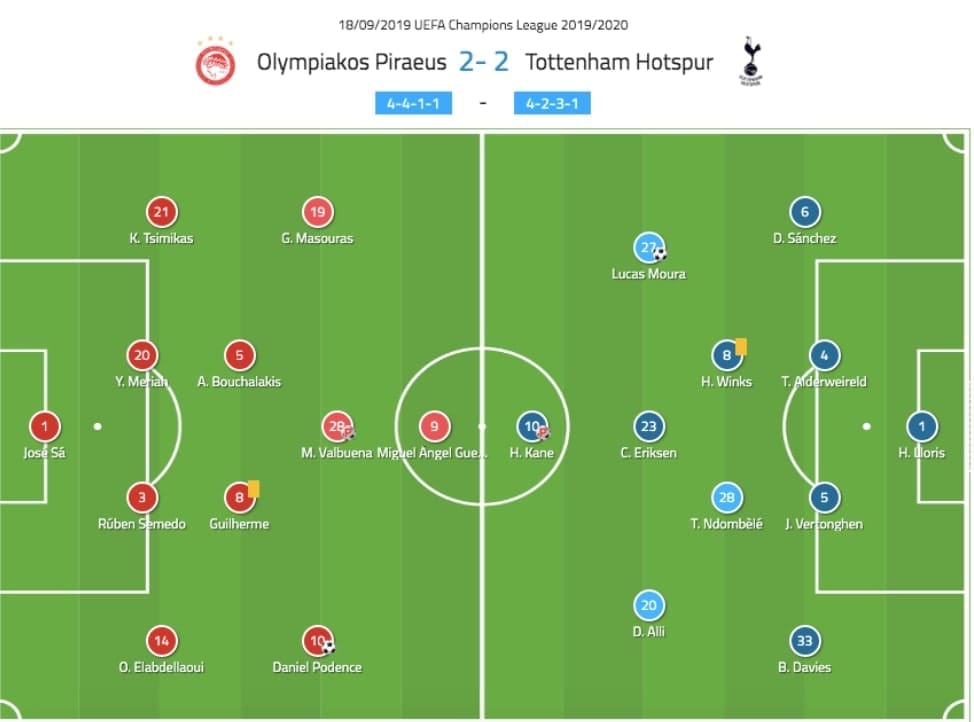
Olympiacos have had a strong start this season; they won their previous eight games with a 4-2-3-1 formation. Pedro Martins used the same formation. Former French national team player Mathieu Valbuena and former Sporting CB centre back Rúben Semedo both started.
Pochettino rotated his squad. They also played in a 4-2-3-1 formation. Despite winning against Crystal Palace by four goals on the weekend, some players were benched. Heung-min Son, Moussa Sissoko, Erik Lamela, Serge Aurier and Danny Rose did not start. Lucas Moura, Dele Alli, Ndombele, and Davinson Sánchez and Ben Davies started instead.
Tottenham’s build-up
In this analysis, we will first investigate Tottenham’s tactics. Tottenham’s build-up structure was solid. They did not want to give possession cheaply in this phase. Since Olympiacos did not press intensely, Tottenham could move the ball without pressure during the build-up. The following two examples illustrated their build-up.
The build-up of Tottenham consisted of the centre backs and the double pivot. Their full-backs Sánchez and Davies provided width down the flanks. In the below image, Harry Winks dropped between Toby Alderweireld and Sánchez to link plays. The advantages were the numerical superiority created against two Olympiacos front players. Also, Winks’ positioning shortened the distance between players to prevent the pass from being intercepted.
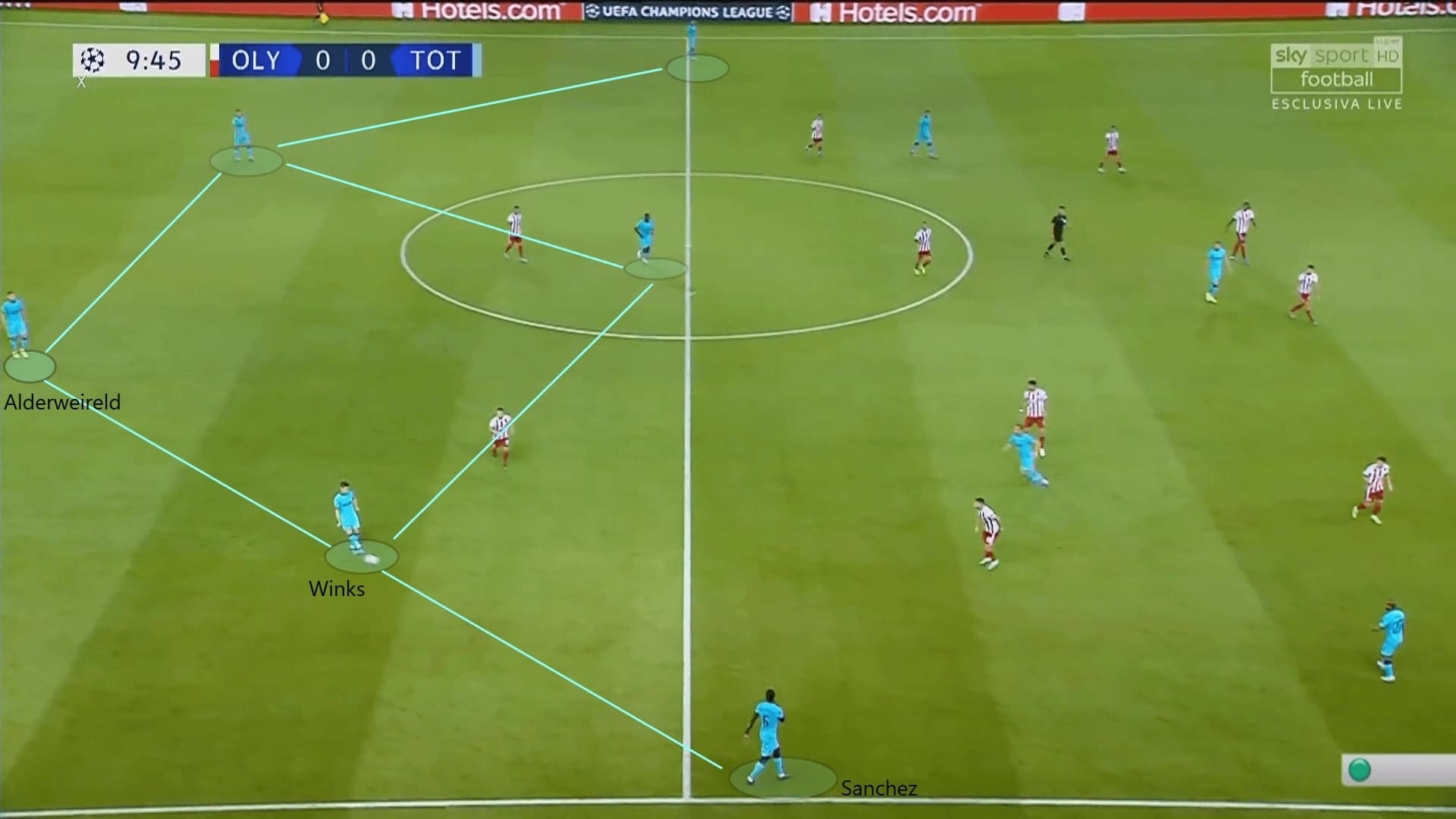
In the second image, we see another form of build-up by Tottenham when the pivot did not link plays. Instead, the pivots and centre-backs formed a box to progress the ball behind the two Olympiacos front players. Winks and Ndombele found themselves between the lines. Meanwhile, Tottenham’s front players stayed in the centre to overload the area, forcing Olympiacos’ defensive line to stay narrow. Therefore, both flanks were free.
Davies read the space down the left flank and Winks also noticed that. With time to make a pass, Winks could play long to hit that space. With this setup, Tottenham could enter the final third.
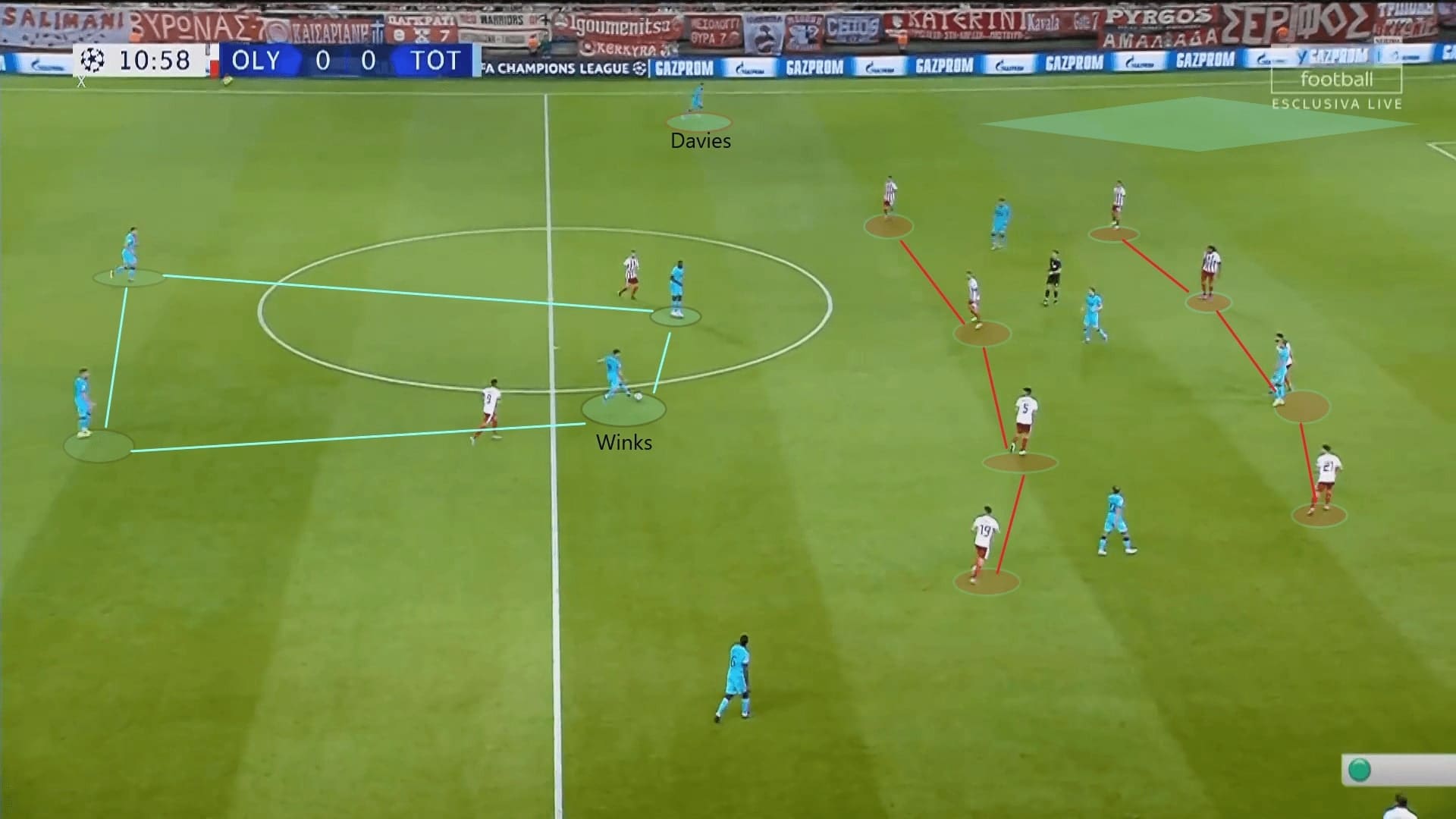
Tottenham in the final third
The below image showed the game plan of Tottenham in the final third. The tactical concepts were similar, they wanted to keep Olympiacos’ defence narrow so to create space down both sides. Players stayed centre to draw the attention of oppositions, they kept moving and rotating their positions so to find the chance to penetrate the centre with quick passes.
This was how Tottenham won their penalty. Alli, Christian Eriksen and Lucas rotated their positions at the centre; Eriksen was making a forward run to bring away defenders. Meanwhile, Harry Kane was the player to stay at the right flank and was unmarked. Alli chose to pass the ball to Kane. As a result, the English captain challenged the Olympiacos defender one on one and created a penalty for himself to score.
The game plan and intentions of Tottenham were good. However, the players did not execute the plan well. They were slow in the final third, and not desperate enough to break the opposition defence. Fortunately, they were clinical enough to score two, with just two shots on target from three in the first half.
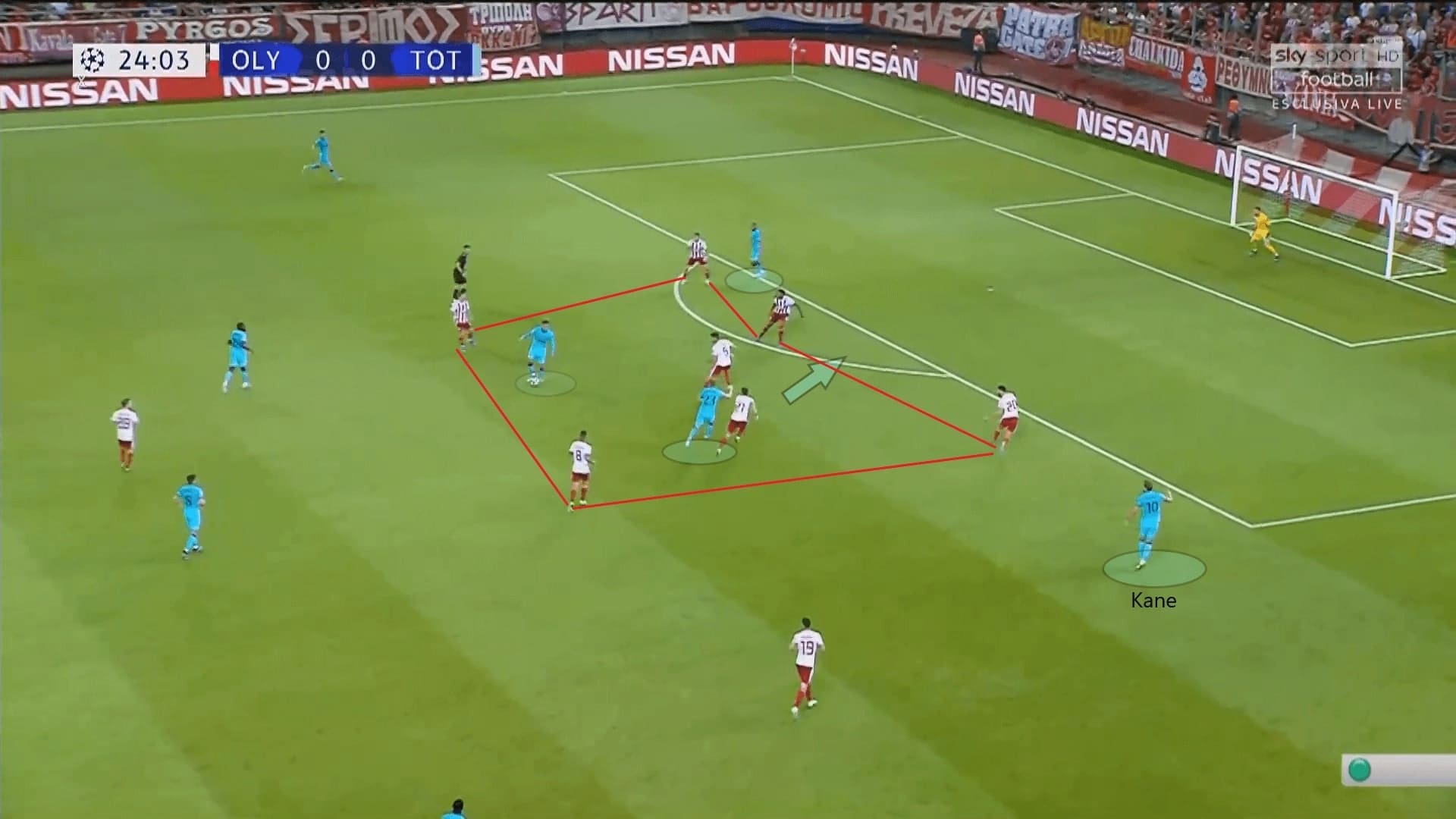
Tottenham off the ball
Tottenham defended in a 4-3-3 shape off the ball. Apart from some occasions, they pressed high (but not intense), and formed a midblock to contain Olympiacos. Eriksen was the player to drop to the midfield line when defending. The block should be compact both vertically and horizontally. Tottenham were a pressing team and their defenders also stepped out to press on many occasions.
The below image showed the defensive structure of Tottenham. They intended to trap Olympiacos on the flanks and compress space, winning possession back. Tottenham’s players maintained a short distance between each other. They were expected to win the ball back. However, Ndombele reacted slowly to close off the opponent and Olympiacos entered the final-third.
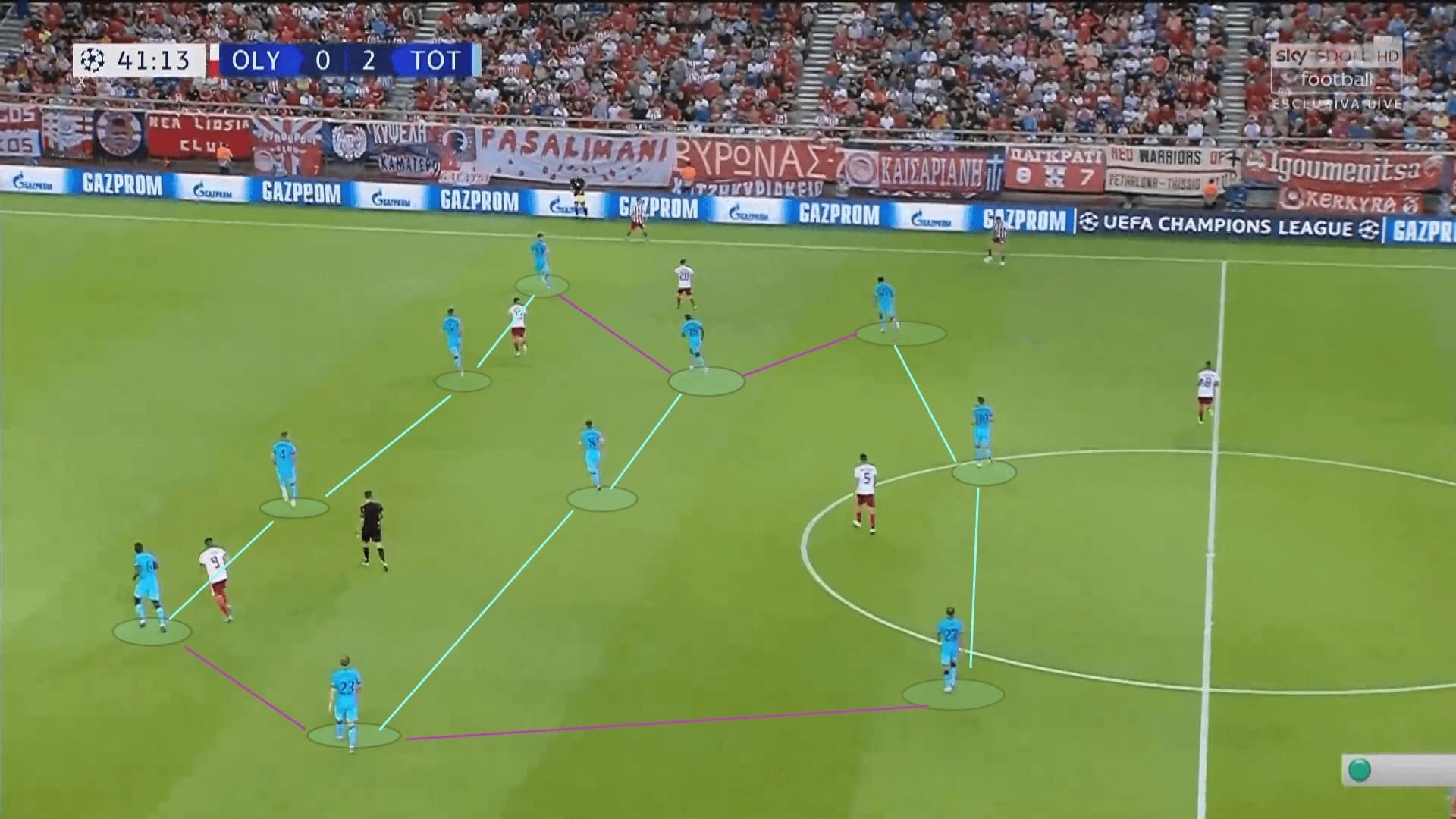
The biggest problem for Tottenham
As mentioned, the Tottenham players were going to step out early, which meant that they needed to recover space left behind also. The midfielders had to stay alert and track any midfield runs of Olympiacos. This was the part that Ndombele did extremely poorly and Tottenham’s backline was exposed.
In order to cooperate with the press, Ndombele positioned himself higher up the pitch. However, he was caught too often, and he did not track runs. This caused the equalizer scored by Daniel Podence.
In the first image, we see that Valbuena dropped deep to provide himself as an option for the pass. Jan Vertonghen followed the Frenchman. Tottenham enjoyed a numerical advantage in this area, with four blue shirts against two Olympiacos players. As a defensive midfielder, Ndombele should have helped his team to win the ball back here.
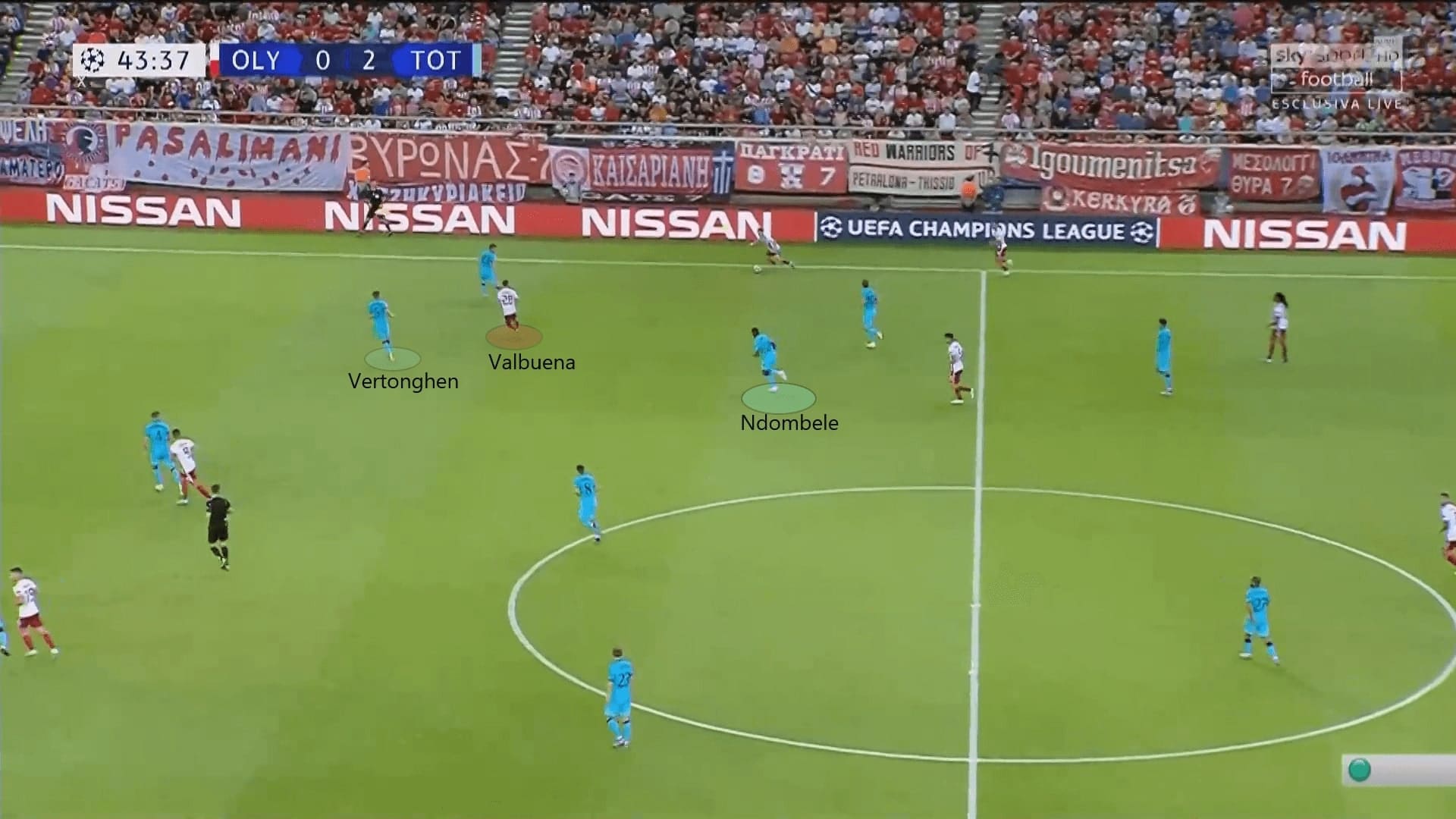
The disappointing point was: Ndombele failed to either track runs or close off the opposition. When the ball was under Valbuena’s feet, Ndombele only focused on Valbuena and totally forgot about Podence, who was making the run from the flank. Ndombele did not even accelerate to track Podence. Meanwhile, space was generated behind Vertonghen, and that was the space that was exploited by the 23-year-old Portuguese to score.
This was not the only case. Similar scenes happened a lot throughout the game, especially in the first half. Tottenham looked fragile in defence due to the lack of midfield protection by Ndombele. The most expensive player of Tottenham was replaced by Sissoko in the 62nd minute of the game.
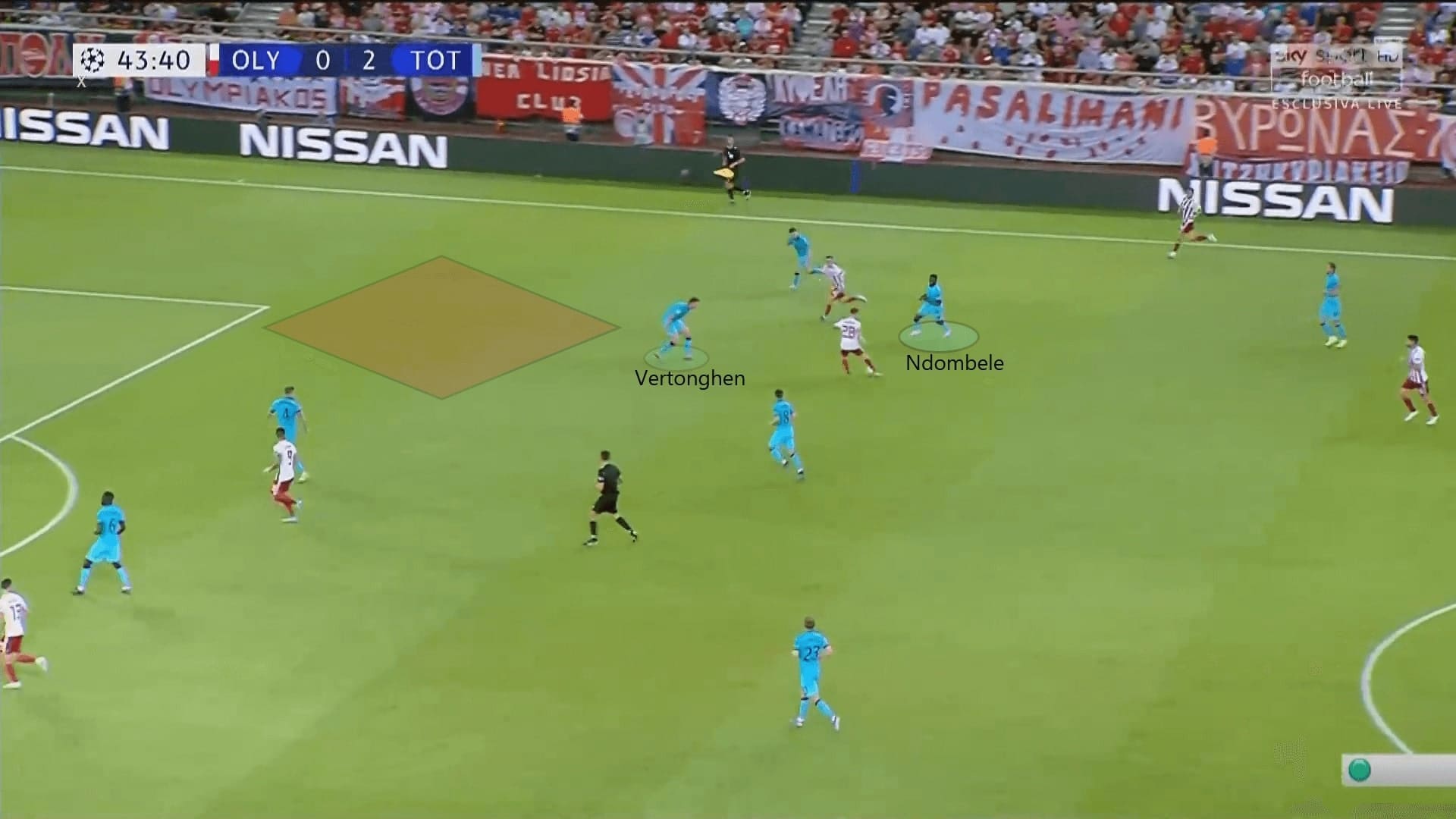
Olympiacos’s third-man combination
Other than creating chances through transitions, Olympiacos also tried to create chances through the build-up. During the build-up, Olympiacos liked to use the third-man combination to break the Tottenham press. They also capitalised on Ndombele’s positioning dilemma to progress the ball.
The below image as an example. All the short passing options for Olympiacos right-back Omar Elabdellaoui were marked. Ndombele was marking Andreas Bouchalakis since Kane blocked the passing lanes towards Semedo. Space behind the pivot was generated. Olympiacos targeted that space and Valbuena dropped to exploit it.
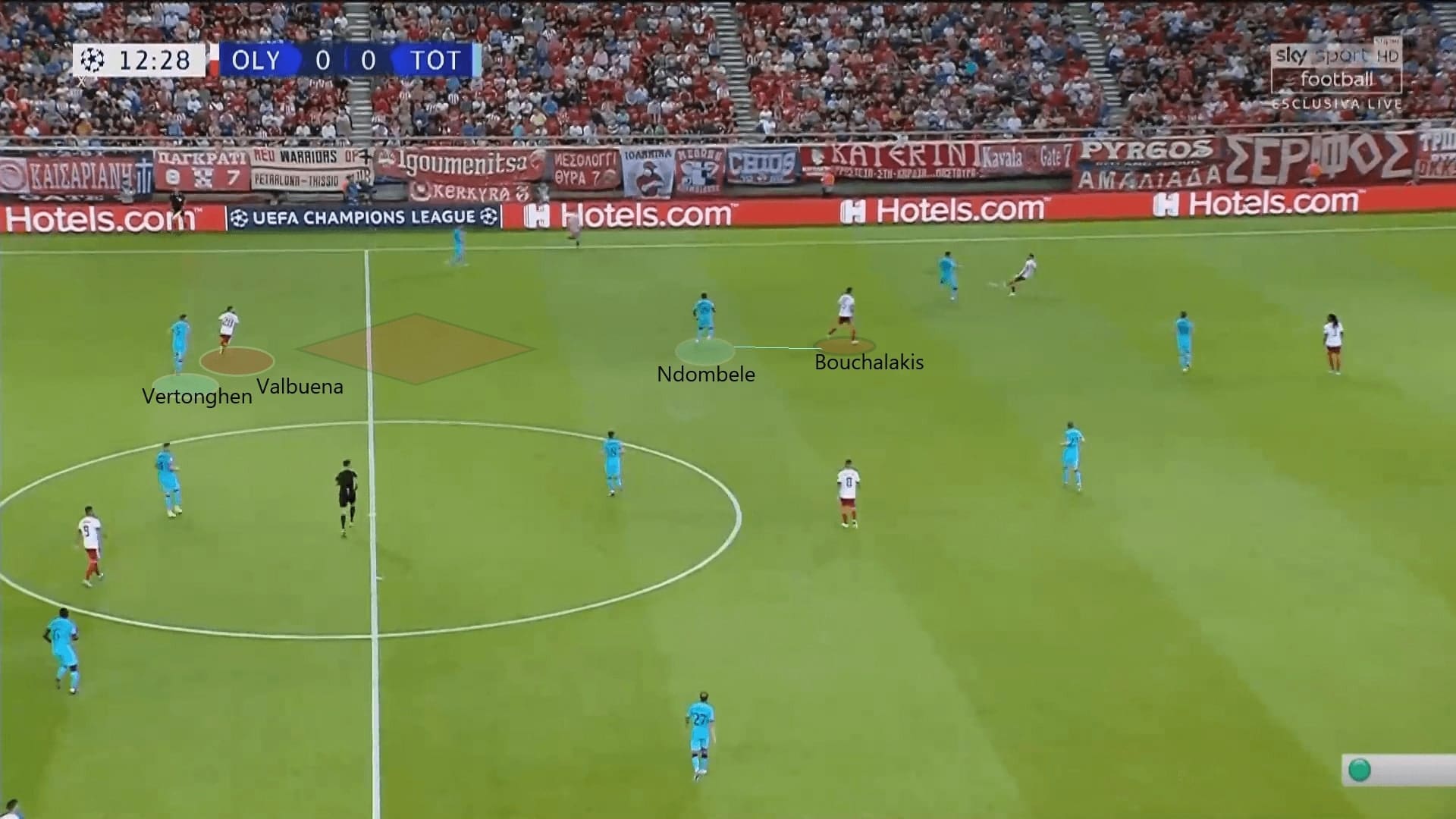
When Valbuena received the ball and drew Vertonghen out, the distance between the two Tottenham centre-backs increased. Meanwhile, Valbuena also used his body to shield the ball, and he laid the ball off to Podence who performed a third man run. Davies could not track Podence and Olympiacos entered the final-third with this approach from times to times. Ndombele was caught out of position and he failed to cover to space between Vertonghen and Alderweireld.
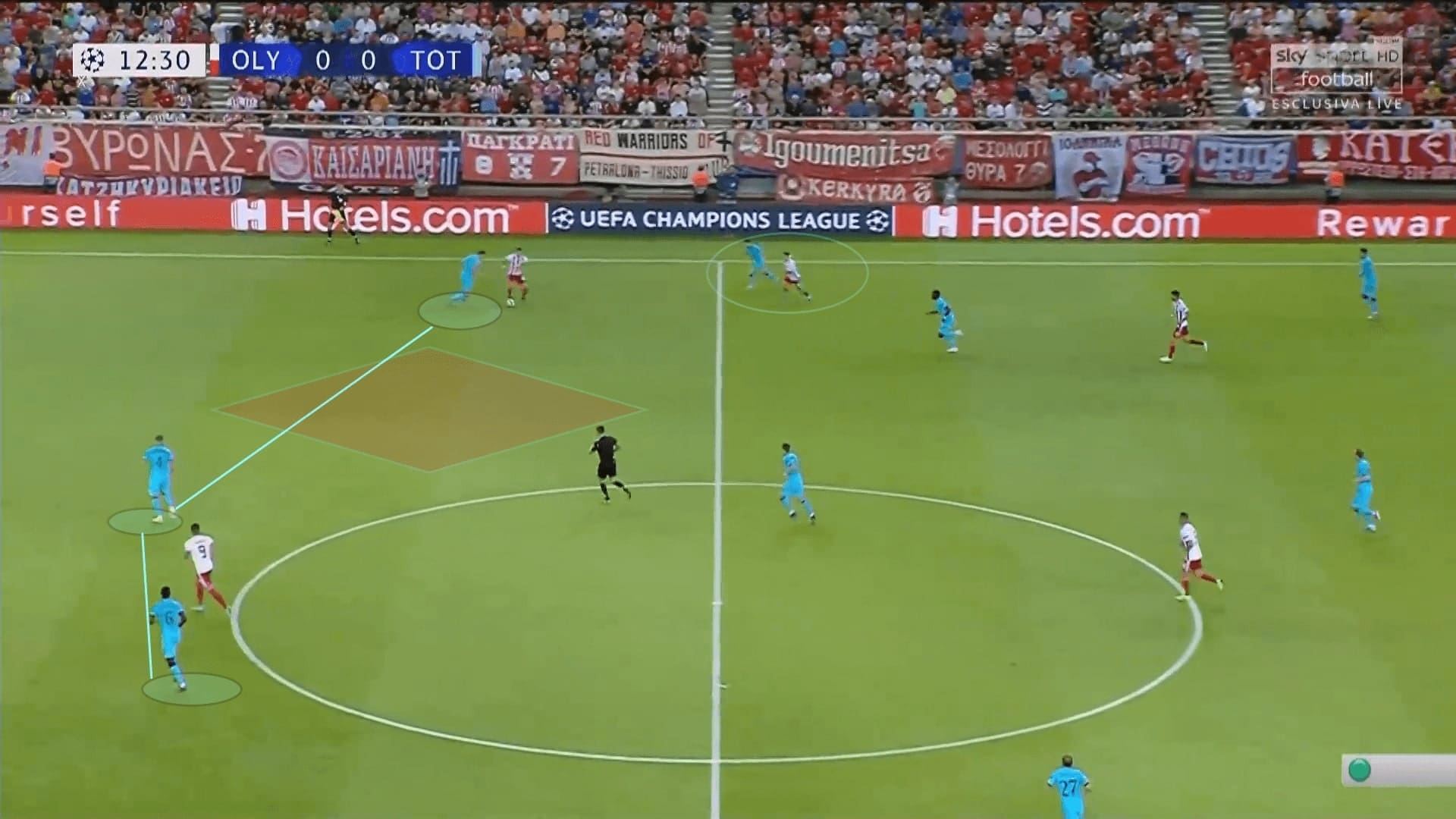
Olympiacos attack wide areas
Other than third-man combinations to hit space behind Ndombele, Olympiacos also targeted the wide areas of Tottenham. They did this by drawing out a Tottenham full-back. As mentioned, Tottenham players usually stepped out to anticipate the pass, but this was a risky approach that would not guarantee success.
Below was an example of Olympiacos hitting space at wide. Tottenham performed the high press with the cooperation of Sánchez. Sánchez could not prevent the backheel pass from Georgios Masouras. Neither Ndombele nor Eriksen tracked Olympiacos left-back Konstantinos Tsimikas’ run. Olympiacos got into the final third again.
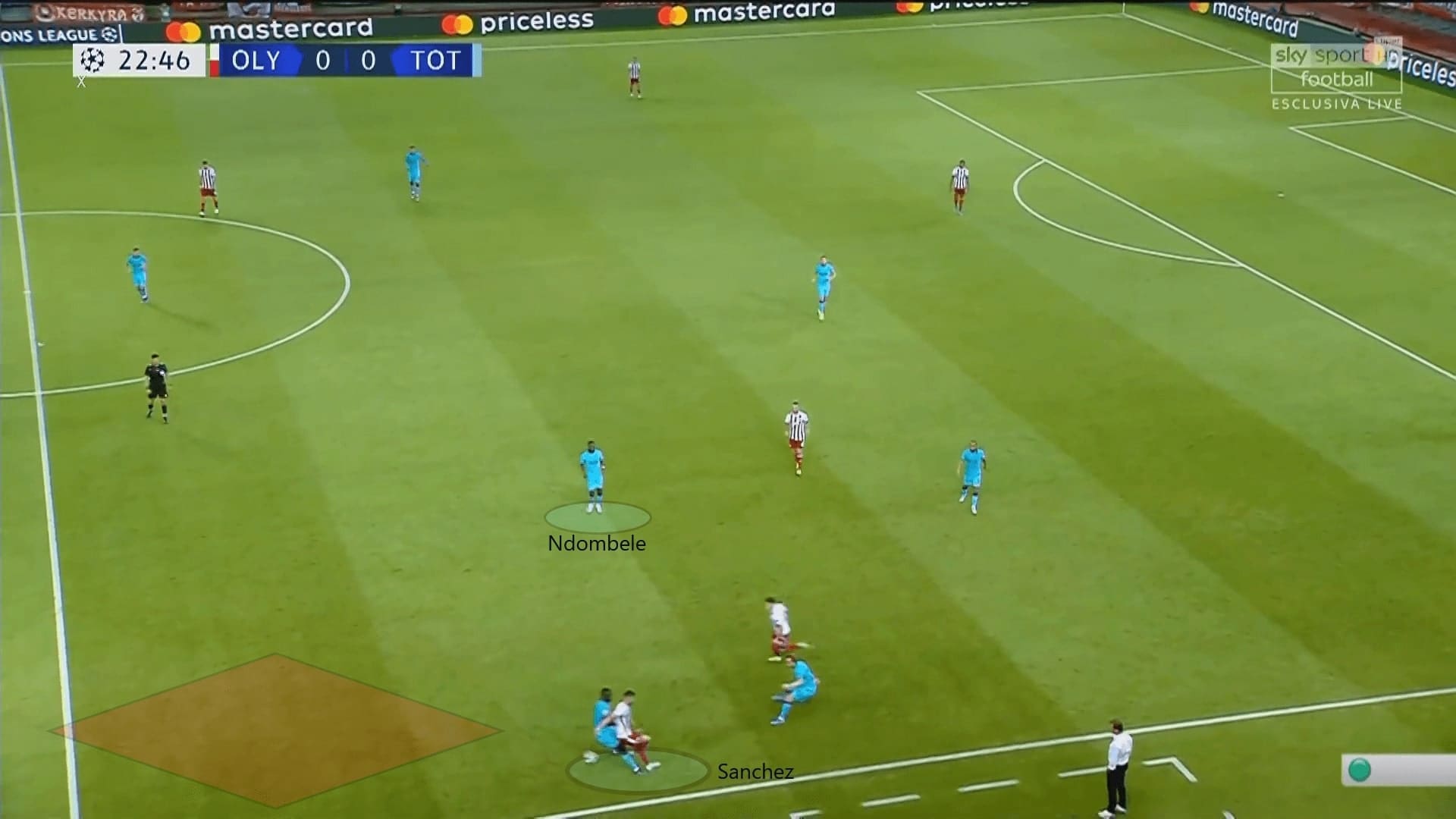
Moura to provide width in the second half
Due to the poor display in the first half, Pochettino made some changes after the break. In the first half, Tottenham used their full-backs, Sánchez and Davies, to provide width at both flanks. However, this approach got its backline exposed. In order to cope with this, Lucas became the man to provide width down the right flank, hugging the touchline. Sánchez could stay deeper to protect the backline.
This was a clever move by Pochettino. Lucas’ pace and skills could provide some new elements down the right flank. He could take on the defenders then change the rhythm of the game, which he did in the first 20 minutes after the break. Later, the Brazilian was tired and Lamela replaced him.
With Sánchez staying on the same line with Ndombele and Winks, now Tottenham got more men to defend quick transitions. In this case, even though Olympiacos cleared the ball upfield, Tottenham still had three players to defend Valbuena and Miguel Guerrero. Tottenham did better to defend transitions in the second half.
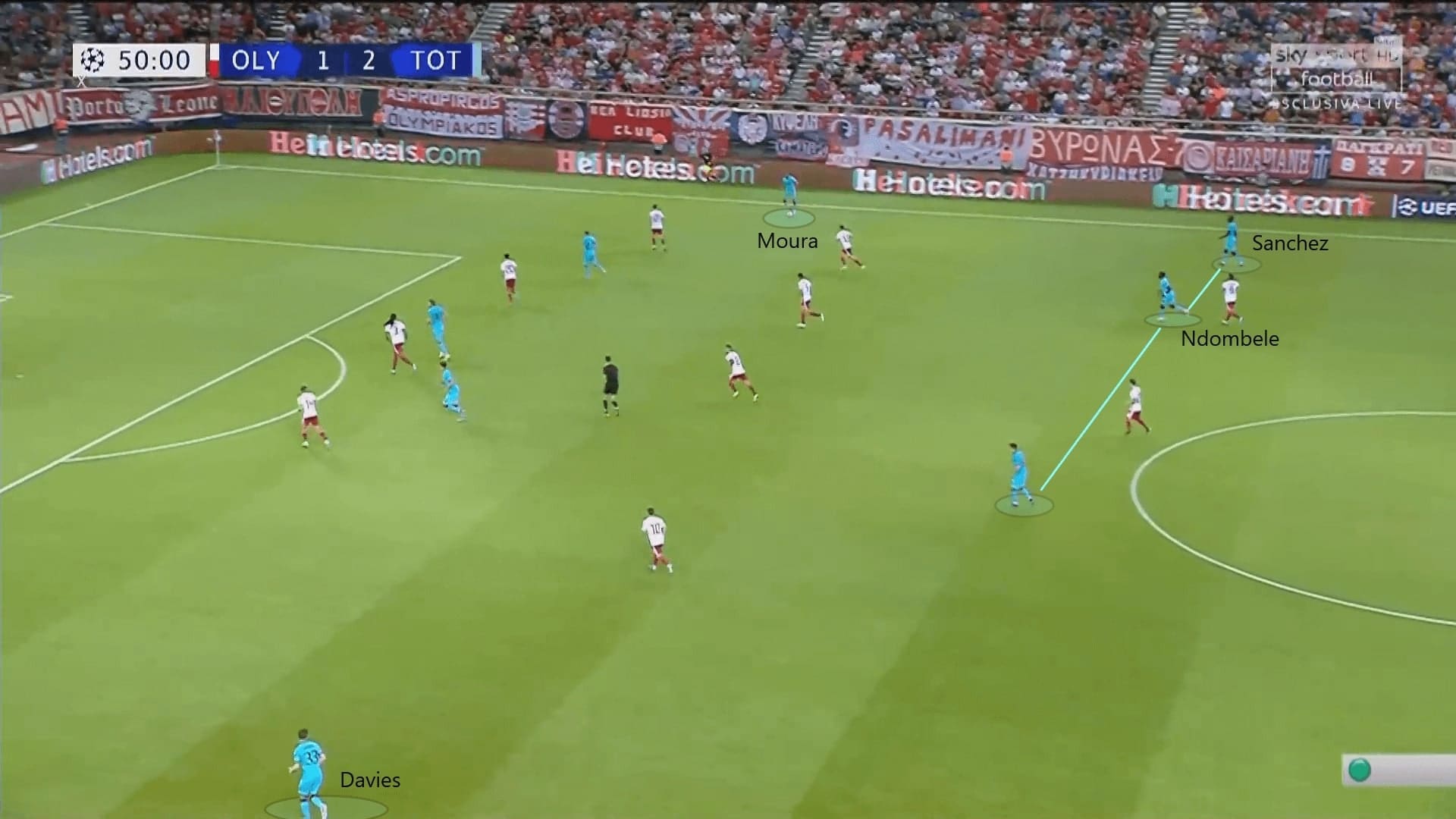
Conclusions
To conclude, this was not the best game from Pochettino’s men. They attacked in a slow tempo which was difficult to break Olympiacos defence. The game plan of Tottenham was fine, but the players did not execute it well. Ndombélé was the most disappointing player on the pitch since he did not fulfil his defensive duties, and he made no significant contributions in the final third. We believe with the return of Son and Sissoko, Tottenham could perform better in the Premier League this weekend.
Olympiacos were good enough to secure a point at home. They were quick in transitions, they were also brave enough to keep the ball under their feet despite Tottenham’s press. They also performed some nice combinations between players to break Tottenham’s defence. It was a good start for them, but they are going to face a stern test again in the future: Bayern Munich.

If you love tactical analysis, then you’ll love the digital magazines from totalfootballanalysis.com – a guaranteed 100+ pages of pure tactical analysis covering topics from the Premier League, Serie A, La Liga, Bundesliga and many, many more. Buy your copy of the August issue for just ₤4.99 here





Comments